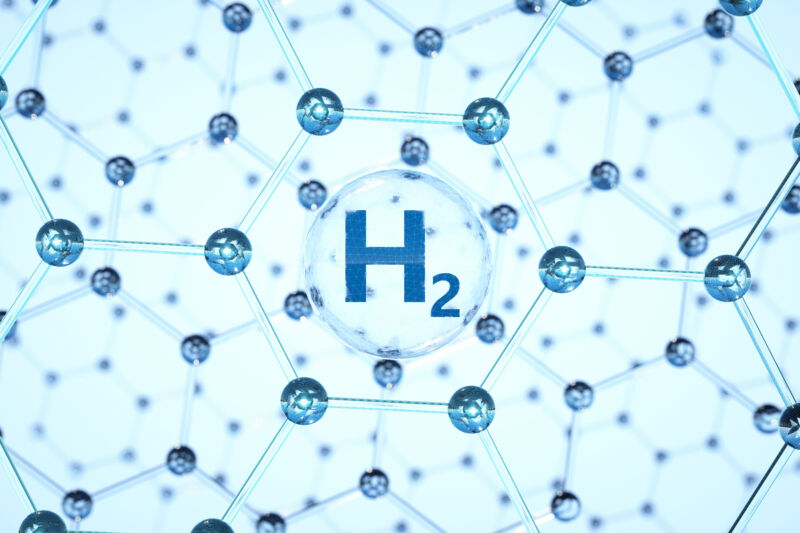With renewable energy becoming cheaper, there's a growing impetus to find ways of economically storing it. Batteries can handle short-term fluxes in production but may not be able to handle longer-term shortfalls or seasonal changes in power output. Hydrogen is one of several options being considered that has the potential to serve as a longer-term bridge between periods of high renewable productivity.
But hydrogen comes with its own issues. Obtaining it by splitting water is pretty inefficient, energy-wise, and storing it for long periods can be challenging. Most hydrogen-producing catalysts also work best with pure water—not necessarily an item that's easy to obtain as climate change is boosting the intensity of droughts.
A group of researchers based in China has now developed a device that can output hydrogen when starting with seawater—in fact, the device needs to be sitting in seawater to work. The key concept for getting it to work will be familiar to anyone who understands how most waterproof clothing works.
I can breathe
Waterproof, breathable clothing relies on a membrane with carefully structured pores. The membrane is made of a material that repels water. It had pores, but they are too small to allow liquid water through. But they're big enough that individual water molecules can pass through. As a result, any water on the outside of the clothing stays there, but any perspiration on the inside that evaporates off will still flow through the fabric and make its way to the outside world. As a result, the fabric breathes.
A similar membrane is central to the function of the new device. It keeps liquid water from transiting across the membrane but allows water vapor to pass through. The big difference is that there's liquid water on both sides of the membrane.
On the outside, there's seawater, with its standard collection of salts. On the inside, there's a concentrated solution of a single salt—potassium hydroxide (KOH) in this case—that's compatible with the hydrogen-producing electrolysis process. Submerged in the KOH solution is a set of electrodes that produce hydrogen and oxygen on either side of a separator, keeping the gas streams pure.
So what happens once the hardware starts operating? As the water inside the device is split, producing hydrogen and oxygen, the reduced water levels increase the concentration of the KOH solution (which had started out much more concentrated than seawater). This makes it energetically favorable for water to move across the membrane from the seawater to dilute the KOH. And, because of the pores, that's possible, but only if the water moves in the vapor form.
As a result, the water briefly exists in the vapor stage while inside the membrane and then quickly returns to liquid once it's inside the device. All the complex mixture of salts in the seawater is left behind outside the membrane, and a constant supply of fresh water is provided to the electrodes that split it. Critically, all of this takes place without the energy use normally involved in desalination, making the overall process more energy-efficient than cleaning up water for use in a standard electrolyzer.
Real-world use
All of this sounds great in principle, but does it actually work? To find out, the team assembled a device and put it to use on Shenzhen Bay seawater (an inlet north of Hong Kong and Macau). And, by nearly every reasonable performance measure, it worked well.
It maintained performance even after 3,200 hours of use, and electron microscopy of the membrane after use indicated that the pores remained unblocked at this point. The KOH used for the system wasn't completely pure, so it contained low levels of the ions found in seawater. But those levels didn't increase over time, confirming that the system kept the seawater out of the electrolysis chamber. Power-wise, the system used about as much as a standard electrolyzer, confirming that the water purification wasn't exacting any energetic cost.
The KOH solution also was self-balancing, with water diffusion into the device slowing if its internal solution became too dilute. If it gets too concentrated, the efficiency of electrolysis drops, so the elimination of water slows down.
The authors estimate their device would handle pressures down to about 75 meters of seawater. The temperature at those depths might be limiting, however, as the diffusion rate of water across the membrane was six times higher at 30° C than it is at 0° C.
Even with all that good news, there are options for improving performance. Various salts beyond KOH are suitable, and some may perform better. The researchers also found that incorporating KOH into a hydrogel around the electrodes boosted hydrogen production. Finally, it's possible that altering the material or structure of the electrodes used in the water splitting could boost things further.
Finally, the team suggested that this might be useful for things in addition to hydrogen production. Instead of seawater, they immersed one of the devices into a dilute lithium solution and found that 200 hours of operation increased the lithium concentrations by more than 40-fold due to water moving into the device. There are plenty of other contexts, like purifying contaminated water, where this sort of concentration ability could be useful.
This doesn't solve all of the problems associated with using hydrogen as an energy storage medium. But it certainly has the potential to allow us to scratch "needs pure water" off the list of those problems.
Nature, 2022. DOI: 10.1038/s41586-022-05379-5 (About DOIs).



3175x175(CURRENT).thumb.jpg.b05acc060982b36f5891ba728e6d953c.jpg)

Recommended Comments
There are no comments to display.
Join the conversation
You can post now and register later. If you have an account, sign in now to post with your account.
Note: Your post will require moderator approval before it will be visible.